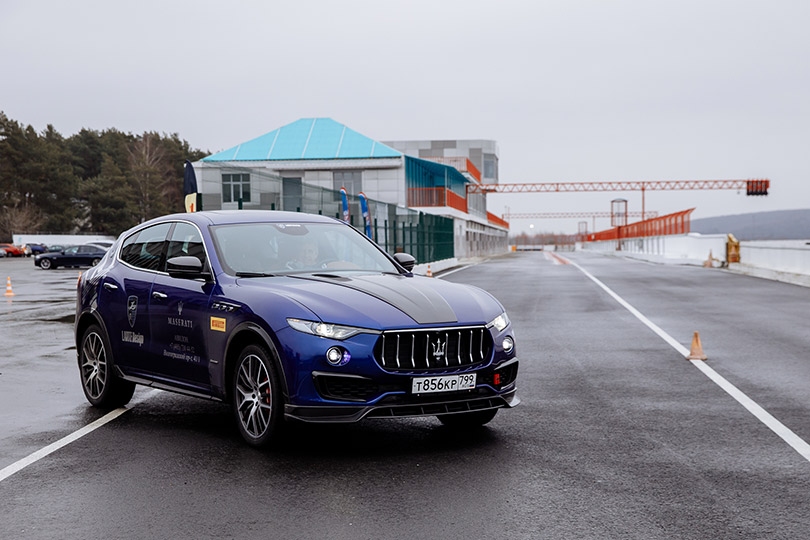As far as luck goes, driving Maseratis on a racetrack near Moscow in the second half of November with no snow in sight must be right up there with winning the lottery. Not the top prize, obviously, but at least the 5th best or so. The cars were brought in by Avilon, the instructors came all the way from Italy, and a twisty section of ADM Raceway was coned off to give us a go at putting several samples of the Levante and a Ghibli through their paces in cold and damp conditions.
I’ve always found Maserati quite an interesting brand because, aside from the fact that they have one of the coolest car logos ever, they could very easily have gone the way of the Dodo bird if history had been slightly different. That they survived as a company and are now thriving, thanks in no small part to the success of their SUV, is something that we can all rejoice about as car enthusiasts. Plus, Italian car brands are a lot like Italian food recipes: you can never have too many.
![]()
Having never actually driven the new Ghibli, I was happy to have a go in that first. The Italian instructor who joined me in the car just as tall as me but even more cheerful (if you can believe that) and we bonded quite well whilst complaining about the fact that people “like us” do struggle to find an optimal seating position in just about any car. This Ghibly was the S Q4 version, meaning a 3 litre turbocharged V6, an 8-speed automatic and all-wheel-drive. With more than 400 horsepower, acceleration was always going to be limited somewhat by the level of adhesion that the Pirelli winter tires could realistically generate on this wet and cold track.
![]()
To be fair, while the track was about as slippery as some frozen lakes that I’ve been onto, these tires provided good feedback and seem to have a pretty stiff sidewall for a winter tire. While I didn’t verify, they were probably from Pirelli’s “Sottozero” line of tires which I’ve used on some of my cars before. They feel uncannily close to a normal low profile summer tire, which is a good thing when you’re trying to feel your way around a slippery track and trying to carry the most speed through a corner without too much slip angle. With the driving mode set to “Sport” the Ghibli was content to let you power your way out of corners slightly sideways, making it easy to balance on the throttle and avoiding the dreaded understeer that plagues so many all-wheel-drive cars. If there was something I’d have liked it was probably a set of shift paddles on the steering wheel, which this car did not have. At least the gear lever, when set to manual mode, did have the “correct” direction for up- and downshifts where pulling the lever backwards means shifting up and pushing it forward shifts down a gear. So I used that instead of trying to live with the fully automatic mode on a racetrack, and it works well enough when you can take a moment to take your right hand off the steering wheel. Still, I’d definitely spec some shift paddles if I was ordering this car.
![]()
The Ghibli’s large Brembo brakes remained solid and easy to modulate throughout the 4 lap run, which is pretty impressive for what is very much a regular road car that isn’t really meant for serious track duty. On the whole, it was a hoot to drive, and the requirement to keep the stability systems turned on didn’t get in the way too much. ADM Raceway has some pretty solid walls that you could run into when you get it wrong, so letting loose a few dozen people with varying degrees of skill and experience in very slippery conditions probably wouldn’t have been the most sensible scenario from a cost-benefit perspective.
Having slightly familiarized ourselves with the way the racetrack went, we were going to have a race of some sort. I say we, there were actually only three of us selected to compete and we were going to be racing each other indirectly via the use of some timing equipment. In any case, a podium finish was going to be a given. The tool for the job was actually going to be the Levante in this case, because why not. It had a bit less power from the same 3 litre turbocharged V6, but at 350 horsepower it was still a lot more power than we could realistically put to good use in these conditions. Handling wise, it was pretty hard to tell that you were in a SUV. Obviously the higher driving position is a big clue, but the lack of serious body roll combined with direct steering and very solid brakes put the Levante far towards the front line of sporty SUVs.
![]()
If there was one thing to quite literally interfere with the driving experience on these “hot” laps, it was that we absolutely had to keep all the safety systems on and even “sport” mode wasn’t allowed. When driving the car in “comfort” mode instead, the traction control system is very sensitive and tries to avoid even the tiniest amount of slip from the wheels. That makes the Levante a very reassuring and safe car to drive in even the worst conditions, but when you’re trying to set a fast lap time it is a bit annoying when the car simply refuses to accelerate quickly out of corners and instead keeps blinking the yellow warning light at you in anger. Even long after exiting the corner and driving straight on, the traction control system was still robbing us of nearly all power in second and third gear and pushing the accelerator down with even more force obviously had no effect. Of course, that simply means that the challenge of going fast just has to be approached slightly differently. Usually, going into corners a little slower in order to exit faster works pretty well in a big and heavy all-wheel-drive car. But in this case, as you could hardly manage to accelerate in between corners at all, trying to lose as little speed as possible through the corners became the priority. Driving the Levante sort of like you would a Mazda MX-5, more or less.
![]()
That, however, was then made difficult by the fact that any driving “mistakes”, as judged by the instructor on the passenger seat, would incur a steep time penalty. Going just a little wide through a corner was enough to get five seconds tacked onto your lap time, a penalty so large that even if you could swap Lewis Hamilton into your car halfway down the lap he wouldn’t be able to make up for it. So a certain degree of caution was required if you wanted to have any chance of a decent result. I think all three of us did screw up our first lap that way, but we were offered two bites at this cherry and I felt like my second lap didn’t leave too much time on the table. The Levante, muzzled though it was in “comfort” mode through no fault of its own, took it all in its stride to the point that I didn’t even notice I was driving an SUV. You just start to focus on getting the car through turns the best you can and at no point did it feel unsuitable to do that.
![]()
In the end I was happy to be called onto the top step, and to receive the coveted prize of an entry into Maserati’s “masters of driving” course in Italy, but the amount of gifts and goodie bags that were bestowed onto us participants was such that I didn’t even manage to ask for the lap time. And I’m not one to insist on basking in the glory of finishing in the top 33 percent of the field unless I somehow managed to absolutely demolish the opposition, of course. That would be silly. So I’ll have to wait and see if I can do the same in Italy on a track that will almost certainly be warmer, hopefully a bit more dry, but certainly with the same exquisite cars on it.









